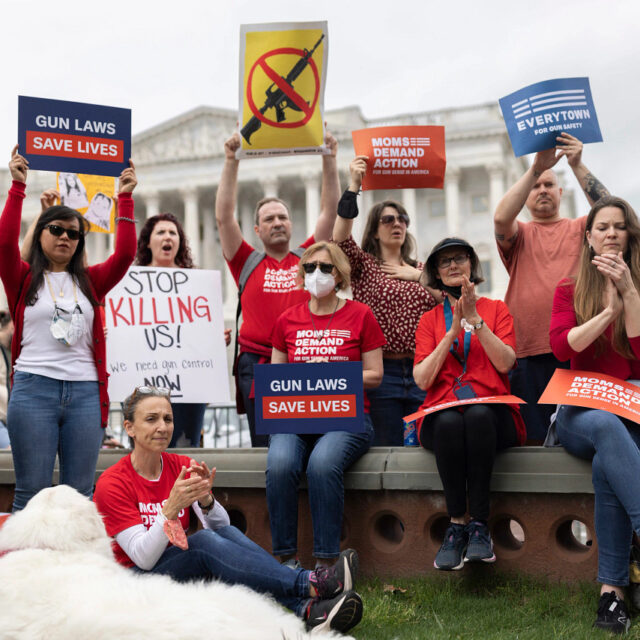H.R. 1236 establishes a federal grant program for states that have Extreme Risk laws with legal standards substantially similar to those described in the bill. The grant funding could be used by states to train law enforcement and court personnel on Extreme Risk laws, develop protocols for enforcement of orders, and raise public awareness of this life-saving process.
H.R. 1236 would also empower federal courts to issue Extreme Risk orders. The legislation establishes clear legal standards for when a federal order could be issued including strong due process protections, and it would give family members and law enforcement in all fifty states a path to take action when they observe someone in crisis.
Extreme Risk laws create an opportunity to intervene before threats turn deadly, and the standards in H.R. 1236 includes robust due process protections.
When a person is in crisis, loved ones and law enforcement are often the first to see signs that they pose a threat. An Extreme Risk law allows them to petition a court for an Extreme Risk Protection order to temporarily remove guns from dangerous situations and prohibit the purchase or possession of firearms while the order is in effect.
An order may only be issued if a judge finds that there is evidence proving that the person poses a significant danger of injuring themselves or others with a firearm.
- A judge can issue a short-term emergency order before a full hearing is held, but only upon finding there is evidence of imminent danger that is likely to occur before a full hearing can be held. Under H.R. 3076, this order lasts only 14 days.
- The final order, generally lasting up to one year (180 days for the federal order), can be issued only following a full hearing for which all parties are given notice and the opportunity to present and respond to evidence. The judge then determines if the evidence presented meets the burden of proof and may issue an Extreme Risk order.
These orders are temporary civil court orders and firearms are returned when the order expires. Extreme Risk laws include provisions to deter people from falsely or maliciously seeking an order.
Nineteen states and the District of Columbia have passed Extreme Risk laws.
Twelve states and the District of Columbia have passed Extreme Risk laws since the shooting in Parkland, including five laws signed by Republican governors.
Data collected from 10 states with Extreme Risk laws shows that 3,900 Extreme Risk petitions were filed between January 2018 and August 2019, and that the filings were spread across the counties in those states.
Perpetrators of mass shootings and school shootings often display warning signs before committing violent acts.
In 51 percent of mass shootings from 2009 to 2017, the attacker exhibited warning signs before the shooting. For example, before killing six people in Isla Vista, California in May 2014, the shooter made homicidal and suicidal threats, and his parents alerted law enforcement. But, there was nothing they could legally do to remove his firearms.
The U.S. Secret Service and the U.S. Department of Education studied targeted school violence incidents and found behavioral warning signs that caused others to be concerned in 93 percent of cases. They also found that in 81 percent of incidents, other people, most often peers, had some type of knowledge about the shooter’s plans. For example, the shooter who killed 17 people and injured 17 others in Parkland, Florida in February 2018 had been expelled from school, and students and teachers reported he displayed threatening behavior. His mother had repeatedly contacted law enforcement.
Interventions in states with Extreme Risk laws have prevented potential mass shootings.
California’s Extreme Risk law has been used in 21 cases as part of efforts to prevent mass shootings. In those cases, fifty-two firearms were recovered and there have been no mass shootings, other homicides, or suicides by persons subject to the orders.
Reports from Maryland, Florida, and Washington show that Extreme Risk laws are being used effectively to avert instances of potential school violence.
Extreme Risk laws address another American gun violence epidemic—firearm suicide.
Nearly two-thirds of gun deaths in America are suicides, with over 22,000 deaths a year, including 1,000 children and teens. Blocking a suicidal person’s access to a gun can save their life. Nearly nine out of ten suicide attempts with a gun result in death. By contrast, most people survive suicide attempts by other means—and don’t go on to die by suicide.
Connecticut’s increased enforcement of its Extreme Risk law was associated with a 14 percent reduction in the state’s firearm suicide rate, and in the 10 years after Indiana passed its Extreme Risk law in 2005, the state’s firearm suicide rate decreased by 7.5 percent.



